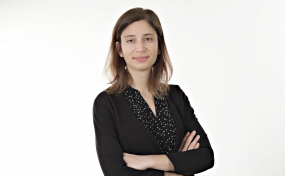Angela Goncalves
Angela Goncalves, Junior Group Leader of Junior Research Group Somatic Evolution and Early Detection, talks about her research at DKFZ, her career and women in science in general.
WHAT IS YOUR FIELD OF RESEARCH AND WHAT FASCINATES YOU MOST ABOUT IT?
I work on cancer prevention. In my group we are interested in finding out how the different organs in the body change when they age and when they are exposed to external factors that damage the DNA in cells (these are things like UV light, alcohol, smoke and other carcinogens). Most of the time when cells get damaged the body is able to cope with it, but sometimes it doesn't and that's when cancer starts. We want to find out what are the circumstances that prevent a damaged tissue from healing itself, and by learning that, come up with strategies for changing its progression to cancer. We do this by looking at aging and damaged tissues using genomics technologies and then computationally integrating vast amounts of information about thousands of genes in hundreds of thousands of cells to build models about what is happening in the tissues. How does the tissue holistically react to damaged cells, how does its composition change, what programs are the genes expressing, what cells communicate with each other?
What fascinates me most about the subject of cancer prevention is that we are actually so good at not getting cancer. Other species are even better than us, like for example naked mole rats or bats. These species practically never get cancer and also live much longer than expected. Anthropocentrism is strong in cancer research, but there is a lot that we can learn by looking at how other species evade it.
WHAT WAS YOUR BIGGEST SUCCESS AND WHAT WAS YOUR BIGGEST CHALLENGE SO FAR?
In the group we are studying how the organs of the female reproductive tract age. As part of this work we've generated and made publicly available a huge reference dataset of ovaries, oviducts, uterus, cervix and vagina in young cycling and in old acyclic mice. This dataset complements other great large scale resources like the Tabula Muris Senis, which included 16 organs of young and old mice, but did not include the female reproductive tract. Studying the young female reproductive tract is complicated because of normal estrus cycling. In mammals these organs are very dynamic throughout the cycle, building themselves up, breaking down and rebuilding every few days. We made a great effort to capture these dynamics and make a reference that is truly useful, we are very proud of it.
Despite the clear value of this work, we still had to contend with comments that these data are only of interest to a specialised audience. The study of female-specific biology has long been disregarded and discounted. We cannot emphasise enough how important it is to understand the neglected tissues of the female reproductive tract (oviduct, cervix, vagina), whose dysregulation and decline contributes enormously to morbidity in aging women.
WHAT CHANGES, IF ANY, ARE NEEDED IN THE SCIENCE SYSTEM TO MAKE IT MORE ATTRACTIVE TO WOMEN IN SCIENCE AND WHAT HAS HELPED YOU MOST TO BE SUCCESSFUL?
Available and affordable childcare, and proper normalisation for output in the evaluation of both male and female scientists with child-caring duties. I could stop there and be content that one of the biggest hurdles is taken care of. But childcare is expensive and quantification of scientific output is extremely difficult, so we are often left trying to find other marginal ways to improve things. I would like to see equity-raising financial aid, such as the one awarded by the Christiane NÜSSLEIN-VOLHARD-foundation to female scientists with child-caring responsibility, be given by institutions by default.
What has helped me succeed has often been having more senior collaboration partners around that I enjoy working with and learning from. Finding good people to work with is one of the most important aspects of starting a group.

